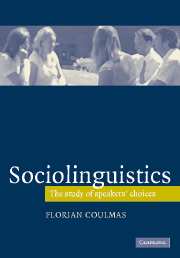
-
Select format
-
- Publisher:
- Cambridge University Press
- Publication date:
- 05 June 2012
- 05 May 2005
- ISBN:
- 9780511815522
- Dimensions:
- Weight & Pages:
- Dimensions:
- Weight & Pages:
- Subjects:
- Sociolinguistics, Language and Linguistics
You may already have access via personal or institutional login- Subjects:
- Sociolinguistics, Language and Linguistics
Book description
This accessible new textbook provides a clear introduction to sociolinguistics, the study of why we speak the way we do, and the social factors that influence our linguistic decisions. Based on the notion of 'choice' - that as speakers we select from the options open to us - it provides a solid theoretical framework to deal with the most fascinating characteristic of language: its variability and diversity. Topics covered include dialects, gender and age specific speech forms, professional jargons, diglossia, bilingualism, code-switching, pidgin languages, and language planning, all of which are unified by the common theme that speakers, by making choices, create their language. Drawing on linguistic variation from a wide range of societies and their languages, this is set to become a key text for all students of sociolinguistics, and will be welcomed by anyone interested in the complex interaction between language and society.
Reviews
'In this state-of-the-art introduction to the field of sociolinguistics, Florian Coulmas' considerable breadth and depth of knowledge is not worn on his sleeve but organised into a pacey and accessible series of thirteen chapters. … I thoroughly commend Coulmas' volume as work of tremendous scholarship and synthesis … His reading is as up-to-date as one can hope for … and his analysis is intelligent, reasoned and humane.'
Source: Journal of Sociolinguistics
'For beginning students, it is an excellent start; for linguistics, it is a useful statement of what a sociolinguist has learned over a long and productive career.'
Source: Journal of Multilingual & Multicultural Development
'This textbook offers a detailed, yet varied, introduction to the theory of Sociolinguistics, working from a micro-perspective and building towards macro-approaches to the study of language variation and change.'
Erin Carrie Source: Journal of Language and Politics
Contents
Metrics
Altmetric attention score
Full text views
Full text views help Loading metrics...
Loading metrics...
* Views captured on Cambridge Core between #date#. This data will be updated every 24 hours.
Usage data cannot currently be displayed.
Accessibility standard: Unknown
Why this information is here
This section outlines the accessibility features of this content - including support for screen readers, full keyboard navigation and high-contrast display options. This may not be relevant for you.
Accessibility Information
Accessibility compliance for the PDF of this book is currently unknown and may be updated in the future.


